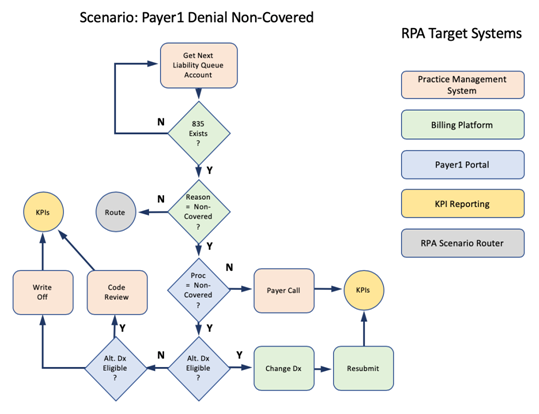A dejected executive at a conference reported how much she's spending on technology and how little benefit her team extracts. "We need technology that works." Her points hit home as she chronicled her experiences, stating that:
- Expensive software prevents effective processes
- Fragmented systems don't integrate and integrated systems aren't flexible
- Investment returns collapse faster than KPIs improve
Her team continually cycles technology to chase process improvements, although promised improvement rarely comes. They're exhausted. This outcome is unfortunately typical in our industry, with providers making huge investments in complex software with hopeful hearts, but struggle with hard results.
Search for Satisfaction
Vee Healthtek is quite familiar with these problems and has a clear path forward in resolving them. We’ve found efficiency and effectiveness in tool integration within our clients' system portfolios. This enables disciplined and creative staff — theirs and ours — to continually improve service levels.
The backbone of our technology approach for improving revenue cycle service levels rests with people and business processes. We train and equip our teams for business process improvement first. Technology only serves that interest.
Our teams overhaul a process working backwards from target outcomes. We map out how to reach the result manually with massive variations in use cases. This helps us find the natural points of discretion for staff and the repetitive scenarios worthy of automation.

We look for sources of data in complex transactions to assemble scenarios, and have determined:
- The source is often in multiple parts of one system, in separate systems, or in databases run by multiple companies
- Transaction architects explore transactions in our clients' production systems to capture the workflow, but also to understand nuances of data errors and corner use cases.
- Each transaction tends to be seen as fully unique. However, we bundle core actions and "scenario" notes to describe promising paths, probabilistic outcomes, and barriers to overcome in unusual account profiles.
The resulting transaction maps, user interface paths and scenarios get quite large. Although this knowledge pays off by growing two assets:
- Skills - Scenario coaching helps guide transaction decisions, giving less-skilled agents a map of the territory and the benefit of an expert guide
- Automation Path - Repetitive events and transaction sequences not requiring human discretion are identified
From these insights, we locate pointless queue rules and data dead-ends as the root causes of revenue leaks and timely filing expirations. We often advise clients on simple application configuration adjustments for big service improvements.
At this point, there’s no technology change involved yet. We just work within the client's current portfolio. However, this is where it gets interesting.
Technology Imitates Humans
We use this base of detailed process data to design technology for breakthrough productivity and accuracy. Transaction scenarios leave the discretion and creativity of human agents in the loop where the complexity seems overwhelming. For repetitive, time consuming transactions, we turn to RPA within our RevAmp workflow automation platform.
Robotic process automation (RPA) imitates a human working in an application. It simply executes scripts to navigate, and to read and write data fields. Solutions to very complex problems emerge from the compounding of basic capabilities. We routinely capture 30% productivity improvement with no client system development needed.
RPA excels at moving data in and out of multiple systems and in using well-formed logic to execute transactions that don’t require a human agent. We craft software “bots” to run scenarios to completion or to escalate to their human handlers when they encounter unexpected barriers.
Here’s one bot process designed to integrate multiple systems in an often-recurring claim denial scenario, for a specific payer. It saves our agents 1.6 minutes for one client about 580 scenarios/month.

We've found, critically, that building bots before we master the business workflow is frustrating, fragile, and ultimately ineffective.
Commercial RPA platforms like UiPath, Blue Prism, WorkFusion and Softomotive prove to be powerful tools in the hands of our process engineers with a body of operational scenarios. They have similar languages and techniques for successfully building professional applications to automate isolated workflow scenarios.
We drive workforce automation with RPA for production costs savings. But this turns out to be merely a side benefit of using technology to enable processes that otherwise can’t be effective. Using integration to enable effective processes is the grail.
Integrate at the User Interface
The power of RPA rests in how the platform improves existing client applications. RPA doesn’t replace or rewrite a modern or legacy application that has been designed to be pretty good at a lot of things. Rather, it leverages the user interface – the screen, mouse, and keyboard – to integrate applications and processes. Systems that were incapable of working together, or that were tedious and error-prone for a human agent to use in unique business processes, become sources of truth for orchestrating workflow and solving problems.
The deep workflow knowledge embedded in an RPA implementation can be breathtaking. A software engineer with a great toolbox can’t crack an automation scenario without the insights of a process engineer. Even then, testing in live systems coughs up unexpected use cases that must be isolated and handled programmatically, or escalated.
On escalation to a human agent, a bot must hand them a clear context of what it was trying to do and where it ran into trouble. The agent will sort out how to finish out the transaction. But they will also describe for the process engineer the unplanned case that led to the error.
Following this process, an expert human agent working within our RevAmp workflow engine, becomes the teacher of bots. In parallel, agents reduce the cognitive load on their colleagues from mundane transaction paths so each can focus their creativity on improving outcomes in more complex problems.
The Integration Payoff
While our journey started with the need to train new agents and reduce the staff count for client workflow volumes, we found a rich mine of improvements, including:
- Technology Without Pain – Additive integration is provided across client systems and our own, to enable our joint team’s success
- Expertise – A rich body of process knowledge is created through which we improve KPIs
- Staff Development – New agents are trained for the hard problems, and leaders are made stronger
- Agent Satisfaction – They work on meaty, creativity-demanding problems, and herd bots on the side to do the grunt work
- Fire and Forget – Opportunities arise for incorporating human insights from isolated systems into a workflow, without slowing the agent down with tedious copy-and-paste mop up.
- Upstream RCM Improvements – Feedback is provided to processes for authorization, coding and scrubbing to reduce avoidable errors, thus eliminating volume on the back end.
- Great KPIs – Near 100% quality is provided, blemished only by increasingly rare corner cases that we incorporate into our knowledge base.
- 30% Savings – Less headcount is needed for the same management scope, which we share with our clients.
We’ve been pleased to bring our clients technology that works by integrating processes and people to serve their business driver. With deep process insights and the increased effectiveness and efficiency of our team, we give our clients continuing improvements in cash flow, A/R days, and net denial write-offs.
